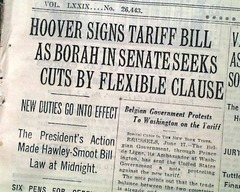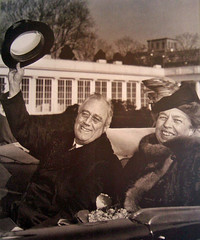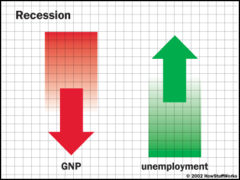AMSCO United States History 2015 Edition, Chapter 24 The Great Depression and the New Deal, 1929-1939
| 9017097212 | stock market crash | A boom stock market of 1928 led to a sell off starting in October 1929. Within three years the stock market would decline to one-ninth of its peak. (p. 497) |  | 0 |
| 9017097213 | Black Tuesday | On October 29, 1929, millions of panicky investors sold, as the bottom fell out of the stock market. (p. 497) |  | 1 |
| 9017097214 | Dow Jones index | The Wall Street stock market index. In September 1929 the index was at a high of 381, in three months it fell to 198. Three years later, the index would finally hit bottom at 41, less than one-ninth of the peak. (p. 497) |  | 2 |
| 9017097215 | buying on margin | This purchase method allowed people to borrow most of the cost of the stock, making down payments as low as 10 percent. Investors depended on the price of the stock increasing so they could repay their loans. (p. 497) |  | 3 |
| 9017097216 | uneven income distribution | Wages had risen relatively little compared to the large increases in productivity and corporate profits. Economic success was not shared by all, as the top 5 percent of the richest Americans received over 33 percent of all income. (p. 497) |  | 4 |
| 9017097217 | excessive debt | Consumers and businesses believed the economic boom was permanent so they increased borrowing, which later led to loan defaults and bank failures. (p. 498) |  | 5 |
| 9017097218 | overproduction | Business growth, aided by increased productivity and use of credit, had produced a volume of goods that workers with stagnant wages could not continue to purchase. (p. 498) |  | 6 |
| 9017097219 | Federal Reserve | During the Great Depression, the Federal Reserve followed a tight money policy. Instead of trying to stabilize banks, the money supply and prices, they tried to preserve the gold standard. (p. 498) |  | 7 |
| 9017097220 | postwar Europe | Europe had not recovered from World War I and the U.S. insistence on loan repayment and tariffs weaken Europe and contributed to the Worldwide depression. (p. 498) |  | 8 |
| 9017097221 | debts and high tariffs | Leading up to the Great Depression, the United States insisted on full World War I loan repayments and high tariffs on imports. This weakened Europe and contributed to the worldwide depression. (p. 498) |  | 9 |
| 9017097222 | Gross National Product | The value of all the goods and services produced by a nation in one year. In 1929, the United States Gross National Product was $104 billion, but it dropped to $56 billion in 1932. (p. 498) |  | 10 |
| 9017097223 | unemployment | By 1933 25% of the workforce, not including farmers, did not have employment. (p. 498) |  | 11 |
| 9017097224 | bank failures | During the Great Depression 20 percent of all banks failed. (p. 498) |  | 12 |
| 9017097225 | poverty and homeless | During the Great Depression poverty and homelessness increased. (p. 499) |  | 13 |
| 9017097226 | Herbert Hoover | He was President of the United States at the time of the stock market crash. He thought that prosperity would soon return. He was slow to call for legislative action and he thought public relief should come from the state and local governments, not the federal government. (p. 500) |  | 14 |
| 9017097227 | self-reliance | President Herbert Hoover did not ask Congress for legislative action on the economy until the summer of 1930. He was concerned that government assistance to individuals would destroy their self-reliance. (p. 500) |  | 15 |
| 9017097228 | Hawley-Smoot Tariff | In June 1930, President Hoover signed into law the highest tariff rates in history, ranging from 31 to 49 percent. In retaliation, European countries enacted their own tariffs. This reduced trade for all nations and worsened the worldwide depression. (p. 500) |  | 16 |
| 9017097229 | debt moratorium | Suspension on the payment of international debts. In 1931, President Hoover proposed a suspension of international debt payments. (p. 500) |  | 17 |
| 9017097230 | Farm Board | It was authorized to help farmers stabilize prices by temporarily holding surplus grain and cotton in storage. (p. 500) |  | 18 |
| 9017097231 | Reconstruction Finance Corporation | In 1932, Congress funded this government-owned corporation as a measure for propping up faltering railroads, banks, life insurance companies, and other financial institutions. President Hoover thought that emergency loans would stabilize key business and the benefits would "trickle down" to smaller businesses and ultimately bring recovery. (p. 501) |  | 19 |
| 9017097232 | Twentieth Amendment | Also known as the lame-duck amendment, this amendment shortened the period between the presidential election and inauguration. The new president's term would start on January 20. (p. 502) |  | 20 |
| 9017097233 | bonus march | Thousands of unemployed World War I veterans marched to Washington, D.C. and set up encampments to demand immediately payment of the bonuses promised to them at a later date. The Army, led by General Douglas MacArthur broke up the encampment. (p. 501) |  | 21 |
| 9017097234 | Franklin D. Roosevelt | This Democratic candidate won the 1932 presidential election. As a candidate, he promised a "new deal" for the American people, the repeal of Prohibition, aid for the unemployed, and cuts in government spending. (p. 502) |  | 22 |
| 9017097235 | Eleanor Roosevelt | She was the most active first lady in history, writing a newspaper column, giving speeches, and traveling the country. She served as the president's social conscience and influenced him to support minorities. (p. 502) |  | 23 |
| 9017097236 | New Deal | Franklin D. Roosevelt's plan to help people at the bottom of the economic pyramid. (p. 503) |  | 24 |
| 9017097237 | relief, recovery, reform | The New Deal included the three R's: relief for people out of work, recovery for business and the economy, and reform of American economic institutions. (p. 503) |  | 25 |
| 9017097238 | Brain Trust | For advice on economic matters, Roosevelt turned to a group of university professors. (p. 503) |  | 26 |
| 9017097239 | Frances Perkins | Roosevelt's secretary of labor, she was the first woman to serve in a president's cabinet. (p. 503) |  | 27 |
| 9017097240 | Hundred Days | On March 4, 1933, Franklin Roosevelt started his term and called Congress into a one hundred day session. They passed into law all of Roosevelt's legislation. (p. 503) |  | 28 |
| 9017097241 | repeal of Prohibition | In 1933, the 21st Amendment was passed. It repealed the 18th Amendment. This ended Prohibition. (p. 503) |  | 29 |
| 9017097242 | bank holiday | President Franklin Roosevelt ordered the banks to be closed on March 6, 1933. He made a radio address explaining that the banks would be reopened after allowing enough time for the government to reorganize them on a sound basis. (p. 503) |  | 30 |
| 9017097243 | fireside chats | President Franklin Roosevelt spoke on the radio to the American people. (p. 504) |  | 31 |
| 9017097244 | Federal Deposit Insurance Corporation | This agency guaranteed individual bank deposits. (p. 504) |  | 32 |
| 9017097245 | Public Works Administration | Directed by Secretary of the Interior Harold Ickes, it allotted money to state and local governments for building roads, bridges, dams, and other public works. (p. 504) |  | 33 |
| 9017097246 | Harold Ickes | President Franklin D. Roosevelt's secretary of the interior. (p. 504) |  | 34 |
| 9017097247 | Civilian Conservation Corp | This organization employed young men for projects on federal lands and paid their families small monthly sums. (p. 504) |  | 35 |
| 9017097248 | Tennessee Valley Authority | A government corporation that hired thousands of people in the Tennessee Valley, to build dams, operate electric power plants, control flooding, and erosion, and manufacture fertilizer. (p. 505) |  | 36 |
| 9017097249 | National Recovery Administration | Directed by Hugh Johnson, this agency attempted to guarantee reasonable profits for business and fair wages and hours for labor. The complex program operated with limited success for two years before the Supreme Court declared it unconstitutional. (p. 505) |  | 37 |
| 9017097250 | Schechter v. U.S. | In 1935, the Supreme Court declared the National Recovery Administration (NRA) unconstitutional. (p. 505) |  | 38 |
| 9017097251 | Securities and Exchange Commission | This agency was created to regulate the stock market and to place strict limits on the kind of speculative practices that led to the 1929 stock crash. (p. 505) |  | 39 |
| 9017097252 | Federal Housing Administration | It insured bank loans for building new houses and repairing old ones. (p. 505) |  | 40 |
| 9017097253 | Works Progress Administration | This agency created in 1935, part of the Second New Deal, it was much more ambitious than earlier efforts. Between 1935 and 1940 up to 3.4 million people were hired to construct bridges, roads, airports, and public buildings. Artists, writers, actors, and photographers were also employed. (p. 506) |  | 41 |
| 9017097254 | Harry Hopkins | He headed the Works Progress Administration (WPA) in the 1930s. (p. 506) |  | 42 |
| 9017097255 | National Labor Relations (Wagner) Act | A 1935 act that guaranteed a worker's right to join a union and a union's right to bargain collectively. It outlawed business practices that were unfair to labor. (p. 507) |  | 43 |
| 9017097256 | Social Security Act | In 1935, this act created a federal insurance program based on the automatic collection of taxes from employees and employers throughout people's working careers. Monthly payments would be made to retired people over the age of 65. (p. 507) |  | 44 |
| 9017097257 | election of 1936 | Franklin D. Roosevelt easily defeated the Republican nominee, Alf Landon. (p. 507) |  | 45 |
| 9017097258 | New Deal coalition | From the 1930s to 1960s, this political coalition consisted of the Solid South, white ethnic groups in cities, midwestern farmers, labor unions, and liberals. (p. 508) |  | 46 |
| 9017097259 | John Maynard Keynes | British economist, whose theory said that in difficult times government needed to spend well above its tax revenues in order to stimulate economic growth. After the 1937 recession, Roosevelt adopted this strategy, which was successful. (p. 511) |  | 47 |
| 9017097260 | recession of 1937 | In the winter of 1937 the economy went into recession again. The new Social Security tax had reduced consumer spending and at the same time Roosevelt had cut back government spending in hopes of balancing the budget. (p. 511) |  | 48 |
| 9017097261 | Father Charles Coughlin | A Catholic priest who founded the National Union for Social Justice, which called for issuing inflated currency and nationalizing all banks. His radio program attacks on the New Deal were anti-Semitic and Fascist. (p. 508) |  | 49 |
| 9017097262 | Francis Townsend | He proposed a simple plan for guaranteeing a secure income for the elderly. He proposed that a 2 percent federal sales tax be used to create a special fund from which every retired person over the age of 60 would receive $200 a month thus stimulating the economy. (p. 509) |  | 50 |
| 9017097263 | Huey Long | He proposed a "Share Our Wealth" program that promised a minimum annual income of $5000 for every American family to be paid for by taxing the wealthy. In 1935 he challenged Roosevelt's leadership of the Democratic party by becoming a candidate for president but was soon assassinated. (p. 509) |  | 51 |
| 9017097264 | Supreme Court | In 1935, they declared two of President Roosevelt's recovery programs unconstitutional. (p. 509) |  | 52 |
| 9017097265 | reorganization plan | President Franklin Roosevelt proposed a plan that allowed the president to appoint a new Supreme Court justice for each current justice over the age of 70. Congress refused to pass this legislation. (p. 509) |  | 53 |
| 9017097266 | conservative coalition | Republicans and many Democrats were outraged by President Franklin Roosevelt's plan to reorganize the Supreme Court. (p. 509) |  | 54 |
| 9017097267 | Congress of Industrial Organizations | This labor union concentrated on organizing unskilled workers in the automobile, steel, and southern textile industries. (p. 510) |  | 55 |
| 9017097268 | John L. Lewis | He was President of the United Mine Workers Union and Leader of the Congress of Industrial Organizations. (p. 510) |  | 56 |
| 9017097269 | sit-down strike | In 1937 workers at the General Motors plant in Flint, Michigan insisted on the right to join a union by sitting down at the assembly line. (p. 510) |  | 57 |
| 9017097270 | Fair Labor Standards Act | In 1938 this act established a minimum wage, a maximum standard workweek with extra pay for overtime, and child labor restrictions. (p. 511) |  | 58 |
| 9017097271 | minimum wage | Establish minimum pay for workers, initially set at 40 cents per hour. (p. 511) |  | 59 |
| 9017097272 | depression mentality | Millions of people who lived through the Great Depression developed an attitude of insecurity and economic concern that remained throughout their lives. (p. 512) |  | 60 |
| 9017097273 | drought, dust bowl, Okies | A severe drought in the early 1930s and poor farming practices led to the Oklahoma dust bowl. High winds away large amounts of topsoil. (p. 512) |  | 61 |
| 9017097274 | John Steinbeck, "The Grapes of Wrath" | A novelist that wrote about hardships in his classic study of economic heartbreak in 1939, "The Grapes of Wrath". (p. 512) |  | 62 |
| 9017097275 | Marian Anderson | An African American singer who had been refused the use of Constitution Hall, she performed a special concert at the Lincoln Memorial. (p. 513) |  | 63 |
| 9017097276 | Mary McLeod Bethune | One of the African Americans that was appointed to middle-level positions in federal government. She was a leader of efforts for improving education and economic opportunities for women. (p. 513) |  | 64 |
| 9017097277 | Fair Employment Practices Committee | It was set up to assist minorities in gaining jobs in defense industries. (p. 513) |  | 65 |
| 9017097278 | A. Phillip Randolph | Head of Railroad Porters Union who threatened a march on Washington D.C. to demand equal job opportunities for African Americans. (p. 513) |  | 66 |
| 9017097279 | Indian Reorganization (Wheeler-Howard) Act | In 1934 Congress repealed the Dawes Act of 1887 and replaced it with this act which returned lands to the control of tribes and supported preservation of Indian cultures. (p. 513) |  | 67 |
| 9017097280 | Mexican deportation | Discrimination in the New Deal programs and competition for jobs forced thousands of Mexican Americans to return to Mexico. (p. 513) |  | 68 |

